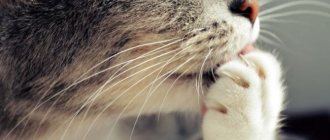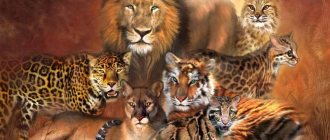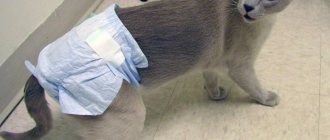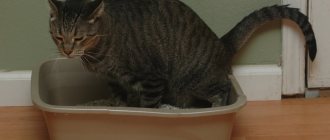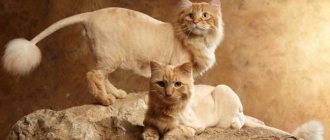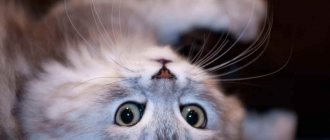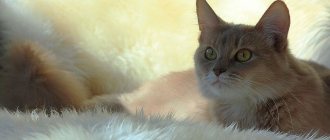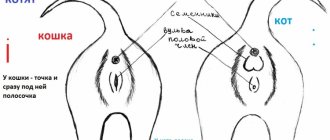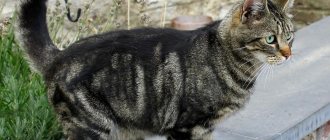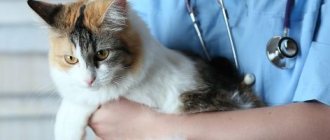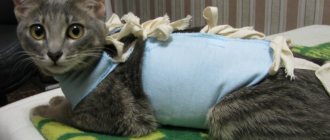Cats... Many people's pets. Some people like red ones, some like black ones, some like mosaic ones. Others are attracted to Persians, Siamese cats or Egyptian cats. It's all a matter of taste.
However, the color of an animal, its exterior, character, diseases, pathologies, mutations depend not only on the breed or lifestyle, but also on the chromosome set (primarily on it), which is constant and definite.
And yet, how many chromosomes does a cat have, what are their numbers and functions? This will be discussed below.
Genome and chromosomes
It is extremely difficult to talk about how many chromosomes a cat has without basic knowledge of genetics.
A genome is a structure that contains the genetic information of an organism. Almost every cell contains a genome. But the chromosome contains all the information about the structure of the cell. A chromosome is a nucleoprotein structure in the nucleus of a eukaryotic cell. The chromosome contains a significant part of hereditary information, which is stored, implemented and transmitted to the future generation.
A chromosome is a structure in the cell nucleus made up of deoxyribonucleic acid (DNA) and proteins. It is worth recalling that DNA is a macromolecule that ensures storage, transmission from generation to generation, and the implementation of the genetic program for the development of a living organism.
There are two types of chromosomes in different organisms:
Eukaryotic type - characteristic of living organisms (eukaryotes), whose cells contain a nuclear membrane, DNA molecules in the nucleus and mitochondria.
Prokaryotic type - found in organisms whose cells lack a nuclear envelope, and DNA molecules are enclosed in histones (prokaryotes).
Externally, a chromosome looks like a long thread with stringed beads, each of which is a gene. In addition, the gene is located on its strictly fixed part of the chromosome - the locus.
What are chromosomes
XY Chromosomes
Chromosomes are structures found in the cells of living organisms. Each chromosome contains one twisted molecule of DNA - the main keeper of genetic data. Accordingly, chromosomes in living organisms are needed for:
- storage of hereditary information;
- transferring it through replication (doubling) of a DNA molecule and transferring its copy to daughter cells formed as a result of division.
A gene is a section of a DNA molecule that contains complete information about any trait or property of an organism.
Each species of animal or plant has a certain number of chromosomes, which does not change throughout life. They are arranged in pairs, so normally there is always an even number of them. An odd number means a chromosomal defect, for example, 47 chromosomes in a person (Down syndrome).
Number of chromosomes in animals
How many chromosomes are there in cat cells? Any living organism has homologous or paired chromosomes and haploid or unpaired (sex) chromosomes. The latter include the egg and sperm; they have a set of XX and XY, respectively. When dividing, they break up into X, X and X, Y. Depending on the new combination of the pair in the fertilized cell, the sex of the new organism (in our case, a kitten) will be determined.
To the question: “How many chromosomes are there in cat cells?”, genetics gives an exact answer. In a domestic cat, the chromosome set includes 19 pairs of chromosomes (18 paired and 1 unpaired: XX in females and XY in males). The total number of chromosomes in a cat is 38.
In other animals, the number of chromosomes is constant and individual for each species (for example, dogs have 78 chromosomes, horses have 64, cows have 60, and hare has 48). Recall that humans have 46 chromosomes.
Karyotype and chromosome complex of a cat
A karyotype is a paired set of chromosomes with a specific number, size and shape for each animal species. The characteristics of each type of living organism are inherited by karyotype. For example, a karyotypic feature may be the presence of a trunk in elephants. The birth of a baby elephant without a trunk will be a deviation from the karyotypic norm, that is, a pathology.
All cells are paired, the future appearance, appearance, color, and character of the cat depend on them. The last - 19 pair contains sexual information and half of the chromosome set. During the process of fertilization, both parts join together to form a complete cell.
Heredity of cats
There are 38 chromosomes in a cat's somatic cell, which contain DNA molecules with genotypic information. Genotypic manifestations that are reflected in the external appearance of a living organism are called phenotype. Phenotypic manifestations of kittens vary in color and size of the animal.
The offspring have paired genes - one gene from the female, and the other from the male. As you know, genes are divided into dominant (strong) and recessive (weak). Dominant genes are indicated in uppercase, Latin letters, recessive - in lowercase. Depending on their combination, homozygous (AA or aa) and heterozygous (Aa) types are distinguished. The dominant gene manifests itself in both homo- and heterozygous states. The recessive gene will manifest its characteristics only in the homozygous type (aa). This genetic knowledge is useful in calculating the traits of future kittens from the phenotypic expressions of their parents. Here it is important to know which gene responsible for the manifestation of a certain trait is recessive or dominant.
Animal color genes are located on the X chromosome, they are presented in the table below:
| a | Grey |
| b | Chocolate |
| c | Platinum, lilac |
| d | Ginger |
| e | Cream |
| f | Tortoiseshell |
| g | Tortoise blue cream |
| h | Turtle chocolate |
| j | Tortoiseshell lilac |
| n | Black |
| o | Sorel, honey |
| p | Yellow-brown |
| q | Tortoiseshell red-brown |
| r | Tortoiseshell tan |
| s | Smoky |
| w | White |
| y | Gold |
| x | Unregistered color |
Pieces of cat heredity
The science of genetics studies heredity and the number of chromosomes. The number and structure of particles of heredity for each species of animal is a constant parameter and it is called a karyotype. Any deviations can provoke hereditary diseases, the appearance of inactive individuals or new species. All pairs of chromosomes, and a cat has 19 of them, are identical in shape and appearance . The exception is one pair responsible for sexual characteristics - it has particles of heredity of different sizes: the X chromosome that determines the female sex is larger, and the male sex, Y, has a smaller size. The sex of the future individual depends on their combination during fertilization.
The information embedded in DNA is called the genotype, and the external expression of the characteristics is called the phenotype. All genes are paired - one from each cat. One of them is dominant, stronger and determines the manifestation of its characteristics in kittens. The other is recessive, it is oppressed by the dominant and is hidden until required. And when two recessive ones come together - from a cat and a female cat, the result is kittens that are not similar to either one or the other. For example, a white cat and a black cat may produce red offspring if both recessive genes are responsible for the red color. Feline heritable traits are as follows:
- dimensions and contour of the auricle, location of the ears;
- coat color and hair length;
- eye pigmentation;
- tail length and others.
Culling of defective individuals is carried out in order to maintain the purity of the breed based on the analysis of the chromosome set. It is important to keep a record of deviations of noticed disorders in order to try to influence the correction of anomalies through rational feeding and training of cats. In this way, it is possible to uncover suppressed genes that can influence the improvement of the breed or give impetus to the creation of a new one.
Coat color
In a thousand genes of cats there are those that are responsible both for their coloring and for the mutation that leads to a change in the color and structure of the coat. A non-reproductive somatic cell contains in the proto-oncogene elements of a mutation in coat color, which inhibits the migration of melanoblasts. Therefore, the latter cannot penetrate the skin, and the pigment, accordingly, does not reach the hair of the coat. This explains the white coat of the animal.
Some melanoblasts manage to get into the hair follicles on the cat's head, and then colored spots appear on the fur. These cells may well reach the retina of the eyes: with a small number of melanoblasts, the eyes become blue, and with a large number, the animal’s pupils will be yellow.
The same chromosome is also responsible for coat color. The usual structural form of melanoblasts gives the animal a striped color. There are also semi-dominant changes, for example, in the Abyssinian tabi. Homozygous individuals do not have stripes, the color is uniform, and heterozygous individuals with this mutation are distinguished by stripes on the muzzle, paws, and tail. In the case of a recessive change, the transverse stripes on the animal’s fur are deformed into irregular lines on its back, appearing in powerful longitudinal stripes of black color.
A gene mutation affecting the enzyme tyrosinase leads to albinism. This occurs not only in cats, but also in other mammals.
Tyrosinase reduces its activity depending on the temperature of the cats - the lower it is, the more active the enzyme. In such cases, there is intense staining of the peripheral parts of the body: the nose, tips of the paws and tail, and ears in Burmese cats.
Prognosis for children with cry-cat syndrome
about 90%The duration and quality of life of newborns with Lejeune syndrome depends on the following conditions:
- severity of congenital malformations;
- the success of surgical treatment (if necessary) in the first years of life;
- quality of medical care;
- type of genetic mutation (complete absence of arm 5p in the chromosome, partial absence, mosaic or ring mutation);
- individual sessions.
Most often, developmental anomalies of the following systems are found in children with Lejeune syndrome:
- respiratory system;
- genitourinary system;
- cardiovascular system (CVS);
- digestive system;
- eye development abnormalities;
- hernias and their complications.
Genitourinary system
The most common malformations of the genitourinary system in patients with Lejeune syndrome are:
- Hypospadias. Hypospadias is a congenital abnormality of the penis in boys, characterized by the appearance of the urethra in the wrong place. This defect creates great difficulty for children when urinating. There may be pain or urinary retention. Hypospadias can be corrected surgically.
- Hydronephrosis of the kidneys. Hydronephrosis of the kidneys is a pathological condition in which there is a violation of the outflow of formed urine from the kidney to the ureter. The intermediate area where this occurs is called the renal pelvis. Over time, the accumulating fluid in the pelvis leads to overstretching of the walls of the pelvis. Normal kidney tissue (parenchyma) becomes compressed and its cells die. To prevent kidney failure, the outflow of urine is artificially provided, and the malformation is corrected surgically.
pyelonephritis, glomerulonephritis, etc.
The cardiovascular system
heart, sometimes there is simultaneous damage to these anatomical structures, the appearance of additional vessels or, conversely, their absence, change in localization, expansion or narrowing of the lumen of heart failure. Most often, the following symptoms are observed in children with abnormalities in the development of the cardiovascular system:
- cyanosis (blue discoloration) of the skin;
- fainting;
- general weakness;
- slow weight gain;
- dyspnea;
- increased heart rate;
- low or high blood pressure.
Anomalies of eye development
antimongoloid cut, hypertelorism, and other symptoms mentioned above; malnutrition; visual acuity; myopia; blindness
Hernias and their complications
existing, physiologicalIn patients with Lejeune syndrome, two main types of superficial hernias are most often observed:
- Inguinal hernia. With such a hernia, the abdominal organs are mixed into the inguinal canal (anatomical formation located in the groin area). Normally, this canal contains blood vessels, the spermatic cord in men and the ligament of the uterus in women.
- Umbilical hernia. This is one of the types of congenital hernias, in which loops of intestine and other abdominal organs move outside the cavity, under the skin. The outlet for the hernial sac is the navel.
For children with Lejeune syndrome, the main danger is complications of superficial hernias:
- Compression of organs located in the hernial sac. More often, compression of organs occurs in the area of the opening through which the organs exit. This leads to disruption of blood supply and drainage (outflow of lymph and venous blood).
- Dysfunction of organs located in the hernial sac. Impaired organ function is a consequence of their compression. A classic example is coprostasis with an umbilical hernia (stopping the movement of feces in the intestines).
- Inflammation of the organs that are located in the hernial sac. This complication is also a consequence of compression of organs. Inflammation begins due to poor circulation. Organ swelling occurs, bacteria move from one cavity to another, and necrosis (tissue death) develops.
Various combinations of anomalies often occur:
- single-system, in which there is an association of two or more defects within one organ system (for example, changes in several heart valves);
- dual-system, in which there is an association of defects within two systems (for example, open oval window and narrowing of the esophagus);
- multisystem, in which there is damage to organs in different systems (two or more).
Mosaic of cats
The set of cat chromosomes responsible for coloring is localized on the X chromosome. Patterned cats are not uncommon, but there are still fewer three-colored cats than two-colored ones.
In this case, the color is determined by the alleles of the O gene:
O - affects the yellow (or red) color of the fur;
o - responsible for black color.
Tortoiseshell cats are heterozygous for this gene, their genotype is Oo.
Their yellow and black spots develop as a result of random inactivation in early embryogenesis of the X chromosome by the O or o allele. Cats can only be homozygous for this trait (OU - red or OU - black).
Tortoiseshell cats are extremely rare - they are characterized by the chromosomal constitution of XXXY and the genotype OoU. This is the reason for the rare birth rate of mosaic cats (or tortoiseshell cats).
Inheritance of the tricolor color of cats:
Color black – XB gene – genotype – XB XB; HVU;
Red color – Xb gene – genotype – Xb xb; HYU;
Tortoiseshell color – gene – XB; Xb – genotype XB; XH.
Hereditary factors
The karyotype plays a determining role in the heredity of cats. The somatic cell of an animal contains 38 chromosomes, which, in turn, consist of smaller particles - DNA genes. These genes carry information that will certainly be passed on to subsequent generations, with the exception of cases where we are talking about a castrated individual. Any external manifestations in a kitten that are characteristic of its parents are called a phenotype.
Since the number of chromosomes (with the exception of the sex chromosome) is paired, this means that information is transmitted from both the mother and the father. However, the amount of information inherited may vary. It depends on which gene expresses itself to a greater extent.
It is known that they can be dominant and recessive. There is a significant difference here:
| Dominant | Recessive |
| It is the leader, and accordingly, the information stored in it appears in the first generation of the inheritance. Indicated in capital Latin letters | It is not as strong as the dominant one, and therefore, as a rule, manifests itself only in subsequent generations, for example, in the second or even third. Indicated in lowercase Latin letters. |
Depending on the combination of genes, homozygous and heterozygous types are determined. The first is AA or aa, that is, a combination of two dominant or two recessive genes. The second is Aa, a combination of dominant and recessive genes. The stronger gene actively manifests itself in any variant of the combination, but the weaker one - only in homozygous aa.
It is noteworthy that if cats give birth to a kitten with the homozygous type aa, then it may be completely different from its parents, since weak genetics will manifest itself only in its descendants. That is, for example, his “grandchildren” will look like the cat’s parents.
It is the chromosomes that transmit by inheritance such important information as:
- coat color and type;
- eye color;
- tail length and thickness;
- size and location of the ears, shape of the auricle;
- predisposition to certain diseases.
Coat color
Among the set of genes in cats, there are those that are directly responsible for the color of the coat and its structure. This scheme works like this: a non-reproductive somatic cell contains a certain number of such genes. Their task is to inhibit the spread of melanoblasts. This is a pigment that, in fact, gives the coat a particular color. If the gene prevents melanoblasts from reaching the hair, then the hair in this place does not color and remains white. If this gene is not present in certain cells, it means that migration of melanoblasts is possible here, as a result of which the coat color occurs. This is how characteristic spots appear on the animal’s body.
Among the set of genes in cats there are those that are directly responsible for coat color and its structure.
The normal pigment, which is not influenced by genetic information, gives the striped color. But genes can cause melanoblasts to color their fur in different shades. It all depends on the karyotype. Heterozygous cats will have a striped color, while homozygous cats will have a uniform color.
Sometimes a gene mutation is possible, as a result of which the production of the tyrosinase enzyme decreases or even stops. As a result, the animal develops albinism.
Mosaic
When a kitten has one or two colors, this is a normal phenomenon, familiar to everyone. But sometimes a pet can look like a real mosaic, because its fur combines three or even more shades. Why is this happening?
Naturally, it’s all about the genes that make up these structures. The genes responsible for coloring are contained on the X chromosome. The reason for the mosaic pattern is that the chromosome consists of various genes that “color” the coat. That is, there is nothing extraordinary here, although it is a comparative rarity.
Sometimes a pet can look like a real mosaic, because its fur combines three or even more shades
White color of cats
White color at the chromosomal level is the absence of pigment. Pigment cells are blocked by one gene - W. If the genotype of cats contains recessive traits of this gene (ww), then the offspring will be colored, and if there is a dominant trait (WW, Ww) and at the same time in the genome of cats there will be many other designations of gene chromosomes (BOoSsddWw ), then we will still see a completely white cat. However, such cats can carry both spotting and patterning, but only if the offspring do not inherit the W gene.
Chromosomes of a cat with Down syndrome
This disease occurs not only in humans, but also in animals, cats are no exception.
There are many stories and photographs from the lives of such animals on the Internet. Just like people, such animals can live and be active, but visually they differ from healthy ones. Like people, such animals need certain care, care and treatment.
To the question: “How many chromosomes does a Down cat have?”, one can definitely answer: 39.
Down syndrome occurs when another extra chromosome appears in the gene set of chromosome molecules - an odd one. In the case of cats, this is chromosome 39.
A cat with an extra chromosome is rare in nature for the simple reason that the animal does not use drugs, alcohol, or smoke, i.e. the provoking causes of gene mutation are excluded. But still, this is a living organism, sometimes it also has malfunctions.
Scientists and biologists do not have a definite opinion about the extra chromosome. Some say that this cannot happen, others say that it can, and still others claim that this occurs when an animal is artificially bred as an experimental animal.
A cat with 20 chromosomes (the twentieth pair of chromosomes is an extra one) can be found, but it has virtually no chance of reproducing healthy offspring. This, of course, does not mean that such an animal cannot be loved. They are quite cute, but a little unusual, different, but still they are alive. For example, a cat with this syndrome (Maya from America) became the favorite of her owners (Harrison and Lauren). They created their own page on Instagram for the cat and regularly post photos and videos of it. Maya has become a favorite of Internet users; she is quite active and cheerful, although she suffers from shortness of breath and constantly sneezes. But no one bothers her to live for her own pleasure and for the pleasure of her masters.
By the way, you should not confuse a cat's Down syndrome with genetic mutations that lead to physical changes (deformations) in the animal's faces. This occurs in nature more often than Down's disease, and is caused by crossing between cats-relatives (interbreeding). If there are many animals of the same kind in the offspring, then sooner or later physiological changes will occur not only in the appearance of the animals, but will also affect their development as a whole. While breeders can control this, the owners of cats running around their yards are practically unable to track it. Some people abort such offspring, others, on the contrary, take this philosophically and also love their pets.
The principle of inheritance and what do cats inherit?
Genetic information passed down from ancestors is called genotype. Its external manifestations are phenotype. Genes are combined in pairs, one from each parent and may include dominant - strong, the signs of which will appear in the descendant, recessive - weak, which remain hidden in the body. The combination of recessive genes received from parents can lead to the appearance of the offspring that is not similar to them. Black cats and smoke cats can produce cream kittens if they have the recessive cream gene.
Chromosomes pass on information to the descendant that is responsible for:
- location, shape and size of ears;
- color, length, coat structure;
- shape, length and thickness of the tail;
- diseases.
Patterns of gene inheritance are used by specialists to breed cat breeds with specified characteristics. But it would be a mistake to believe that this requires only knowledge of genes, what traits they are responsible for, and the basics of breeding work. In practice, it is necessary to know the fundamental mechanisms of gene operation, which have not yet been sufficiently studied.
At the same time, combinations of genes complicate and expand the possibilities of breeding new breeds, of which there were only about 20 20 years ago, but today there are more than 2 thousand
Of primary importance when selecting and culling individuals for purebred breeding is the consideration of the chromosome complex of cats. In this case, all deviations found in it, as well as flaws in appearance, are taken into account.
Sometimes mutations occur in the set of chromosomes, and cats are born with deformities in appearance or with Down's disease. It is possible to make a forecast regarding the first phenomenon, but with the second it is more difficult, since there are not many studies on the possible origins of this disease.
Genetics is a fairly young science that studies the mechanisms of inheritance of certain traits by living organisms, as well as the laws and patterns of this inheritance. Decoding the cat gene helps to find out how many chromosomes cats and other animals have, what kind of offspring an individual will produce, prevent the continuation of negative mutations and help maintain the purity of the breed.
Interesting things about cats are collected in this video
How many lives does a cat have?
Everyone knows that in 1996 the first cloning was carried out in the world (the famous Dolly the sheep). Five years later, scientists cloned a cat and gave it a name – Kopirka (in Russian) or Carbon Copy (in Latin).
For cloning, a gray-red tortoiseshell cat, Rainbow, was taken. Eggs and somatic cells were extracted from Rainbow's ovaries. Nuclei were removed from all eggs and replaced with nuclei isolated from somatic cells. Electroshock stimulation was then performed and the reconstructed eggs were transplanted into the uterus of a gray tabby cat. It was this surrogate mother who gave birth to Copier.
But Kopirka had no red spots. The study revealed the following: in the genome of a cat (female) there are two X chromosomes, which are responsible specifically for the color of the animal.
In a fertilized cell (zygote), both X chromosomes are active. During the process of cell division and further differentiation in all cells of the body, including future pigment cells, one of the X chromosomes is inactivated (that is, the cell’s activity is lost or greatly reduced). If a cat is heterozygous (for example, Oo) for the color gene, then in some cells the chromosome carrying the red color allele can be inactivated, in others - the chromosome carrying the black color allele. Daughter cells strictly inherit the state of the X chromosome. As a result of this process, the tortoiseshell coloration is formed.
When a cat was cloned in the nucleus of a reconstructed egg extracted from an ordinary somatic cell of a calico cat, complete reactivation (restoration of viability or activity) of the switched off X chromosome did not occur.
Complete reprogramming of the chromosome nucleus does not occur when cloning a living organism (in this case, a cat). It is likely that this is why cloned animals get sick and cannot always produce healthy offspring. The carbon copy is still alive. She became the mother of three adorable kittens.
Siamese replacement
Twenty years ago, the genetic map of a cat's chromosomes contained only a few dozen genes; now their number is approaching two thousand. In particular, color genes have been mapped and deciphered and critical points have been identified, mutations at which lead to color changes.
So, on one of the somatic
(non-sex) chromosomes, two mutations are localized by color.
The dominant white color mutation, located in the c-kit
, disrupts the ability to migrate in
melanoblasts
, the precursors of embryonic pigment cells. And since melanoblasts do not have time to reach the skin in time, the pigment does not get into the hairs. As a result, the fur grows completely white. If sometimes melanoblasts still manage to penetrate the hair follicles located on the cat’s head, then small colored areas appear there. In carriers of this mutation, the number of melanoblasts that reach the retina may vary. If there are a lot of them, then the eyes will have a normal yellow color, if there are very few - blue.
On the same chromosome there is a gene that determines the color pattern. Normal allele
(structural form) of this gene gives the striped, brindle coloration.
Sometimes these stripes are continuous, sometimes they are broken. The semi-dominant mutation Abyssinian tabby
.
In homozygotes
(i.e., in individuals with a pair of identical alleles) for this mutation, no stripes are found on the body: the animals have a uniform color.
But in heterozygotes for this mutation, stripes are located on the tail, muzzle and paws. A recessive mutation in the same gene - marbled tabby
- turns the transverse stripes into curls or irregularly shaped streaks. Often such cats have a wide black stripe running down their backs.
For albinism
– a phenomenon widely found in different species of mammals – there are mutations in the gene encoding the enzyme tyrosinase. In this case, the synthesis of the enzyme is either completely blocked, or a defective enzyme with altered activity is synthesized.
Several such mutations have been described in cats. In homozygotes for the Burmese albinism
Tyrosinase activity is slightly reduced compared to normal. Moreover, the degree of suppression of enzyme activity depends on body temperature: at a lower temperature than normal, it is more active. This is why Burmese cats have more intensely colored areas of fur on the tips of their paws, tail, ears, and nose, that is, in those areas of the body where the temperature is low.
The same can be said regarding the Siamese albinism
. However, the level of depigmentation is much higher: in Siamese cats, the hair on the body, as a rule, has no pigment, and the color remains only on the tips of the paws, tail, ears and nose. But even these areas are less pigmented than in Burmese cats. The eyes are usually blue due to a decrease in the amount of pigment in the retina.
Now we know exactly the molecular nature of these mutations: they are obtained due to the replacement of a single nucleotide in the gene sequence! In Siamese cats, the nucleotide at position 422 from the beginning of the gene is replaced in the gene responsible for the synthesis of tyrosinase. Normal cats have guanine there, while Siamese cats have adenine. As a result, the nucleotide sequence encoding the amino acid arginine was converted into a sequence encoding glycine. Replacement of arginine with glycine in the tyrosinase protein led to a decrease in its enzymatic activity at normal body temperature.
In Burmese cats, a similar weakening of body color is due to a nucleotide substitution at position 227.
